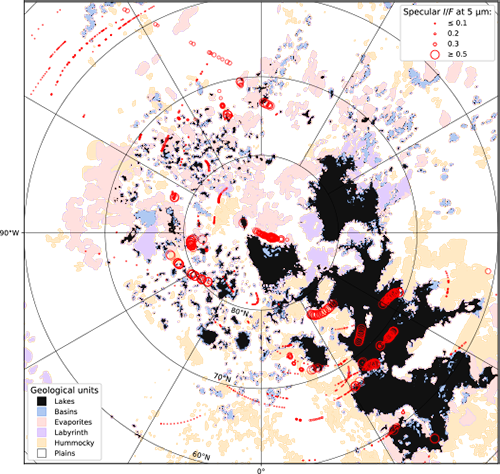Mapping VIMS specular reflections on Titan’s surface during the Cassini mission
- 1Jet Propulsion Laboratory, California Institute of Technology, Pasadena, CA, USA
- 2Department of Physics, University of Idaho, Moscow, ID, USA
Introduction
During T58 flyby (2009), Cassini VIMS recorded 4 spectral cubes containing a very unusual signature with a very high I/F infrared peak around 5 µm in a specular geometry [1]. This observation, located on a radar smooth area [2] was the first confirmation of the presence of large hydrocarbon liquids in Titan’s North Pole. Between 2010 and 2014, a dozen of similar specular signatures were recorded by VIMS above different lakes and mares [3-6]. Modeling the shape of these signals and their spread on the surface, provide new information about the methane-ethane ratio [1], the refractive index of the lakes [3], the transmission spectrum of Titan’s atmosphere [5] and even the roughness of the lake and the height of waves [4, 6]. More recently, off-specular observations also provided new constraints on wetted surfaces [7] and tidal/wind waves [8].
Until now, detection of the specular points in the VIMS dataset were conducted manually on cubes recorded above the North Pole containing a significantly high signal at 5 µm. The purpose of this study is to generalize specular point detections and create a global database of all specular pixels across the entire mission to map their spatial distribution and their spectral variability.
Method
A specular point corresponds to the reflection of a point light source on a perfect flat mirror which happens when the incidence and emergence angles are equal and aligned. More generally, any surface will produce a peak of intensity at the specular point related to its local surface properties. Unfortunately, the location of the specular point on a sphere is not trivial to determine but can be reduce to a quartic polynomial on the specular angle :
is the radius of planet,
the distance to the spacecraft and
the phase angle. For each Titan flyby, we use the SpiceyPy toolkit [9] to extract the position of the Sun as function of Cassini's location. Then, for all VIMS cubes taken by Cassini, we check if the specular point is within the pixel footprint (i.e., the instantaneous field of view, IFOV) when it was acquired.
Results
All the specular pixels are considered, independently of their spectral signature. Between 2004 and 2017, we found 7751 cubes containing at least one specular point. Fig. 1 summarizes the location of all the specular pixels observed around the northern latitudes. We determined 238 specular points above known lakes and 176 specular points have an I/F peak larger than 0.5 in the 5 µm window [10]. Most of the pixels with a strong peak at 5 µm are located on Kraken Mare, close to Punga and Jingpo lacus and in lake district.

Fig. 1: Titan's North Pole with specular point locations (red circles) contained within VIMS IFOVs. The size of the circle is proportional to the mean I/F spectra at 5 µm. Geological units from [11, 12].
We notice that many specular pixels that do not present a strong peak at 5 µm are located on plains. This confirms that the presence of a 5 µm specular peak is highly correlated with the presence of liquid lakes or wetted surfaces.
Conclusions
Tracking specular reflection on the surface of Titan provides many opportunities to probe its local surface properties. We show that approximately 30% of the VIMS cubes contain at least one pixel in a specular geometry. All previously reported specular points [1, 3-6] are included in our database. This represent a large collection of spectra that could help us to better determine the surface and atmospheric properties, the lake content and behavior and bring new insights on the morphology and composition of the surrounding geological units.
Acknowledgments
This work was performed at the Jet Propulsion Laboratory, California Institute of Technology, under contract to NASA. Raw data used in the study are available on the Planetary Data System (pds-imaging.jpl.nasa.gov/volumes/vims.html). Calibrated data are also available on the Nantes Cassini VIMS Data Portal (vims.univ-nantes.fr).
References
[1] Stephan et al. (2010) - doi:10.1029/2009GL042312
[2] Stofan et al. (2007) - doi:10.1038/nature05438
[3] Soderblom et al. (2012) - doi:10.1016/j.icarus.2012.05.030
[4] Barnes et al. (2011) - doi:10.1016/j.icarus.2010.09.022
[5] Barnes et al. (2013) - doi:10.1088/0004-637X/777/2/161
[6] Barnes et al. (2014) - doi:10.1186/s13535-014-0003-4
[7] Dhingra et al. (2020) - doi:10.3847/PSJ/ab9c2b
[8] Heslar et al. (2020) - under review
[9] Annex et al. (2020) - doi:10.21105/joss.02050
[10] Sotin et al. (2005) - doi:10.1038/nature03596
[11] MacKenzie et al. (2014) - doi:10.1016/j.icarus.2014.08.022
[12] Lopes et al. (2019) - doi:10.1038/s41550-019-0917-6
How to cite: Seignovert, B., Sotin, C., Lawrence, K. J., and Heslar, M.: Mapping VIMS specular reflections on Titan’s surface during the Cassini mission, Europlanet Science Congress 2020, online, 21 September–9 Oct 2020, EPSC2020-340, https://doi.org/10.5194/epsc2020-340, 2020

